Related Research Articles

"Junk food" is a term used to describe food that is high in calories from sugar and/or fat, and possibly sodium, making it hyperpalatable, but with little dietary fiber, protein, vitamins, minerals, or other important forms of nutritional value. It is also known as HFSS food. The term junk food is a pejorative dating back to the 1950s. Many different kinds of junk food can be easily found in most supermarkets and fast food restaurants. Because of such easy access to it, people are most likely to consume it.
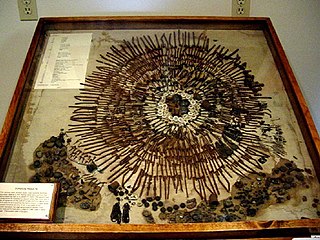
Pica is the eating or craving of things that are not food. It is classified as an eating disorder but can also be the result of an existing mental disorder. The ingested or craved substance may be biological, natural or manmade. The term was drawn directly from the medieval Latin word for magpie, a bird subject to much folklore regarding its opportunistic feeding behaviors.

Mud is soil, loam, silt or clay mixed with water. It is usually formed after rainfall or near water sources. Ancient mud deposits hardened over geological time to form sedimentary rock such as shale or mudstone. When geological deposits of mud are formed in estuaries, the resultant layers are termed bay muds.

Indonesian cuisine is a collection of various regional culinary traditions that formed in the archipelagic nation of Indonesia. There are a wide variety of recipes and cuisines in part because Indonesia is composed of approximately 6,000 populated islands of the total 17,508 in the world's largest archipelago, with more than 1,300 ethnic groups.

Otak-otak is a Southeast Asian fish cake made of ground fish mixed with spices and wrapped in leaf parcels. Otak-otak is traditionally served steamed or grilled, encased within the leaf parcel it is cooked in, and can be eaten solely as a snack or with steamed rice as part of a meal.

Geophagia, also known as geophagy, is the intentional practice of eating earth or soil-like substances such as clay, chalk, or termite mounds. It is a behavioural adaptation that occurs in many non-human animals and has been documented in more than 100 primate species. Geophagy in non-human primates is primarily used for protection from parasites, to provide mineral supplements and to help metabolize toxic compounds from leaves. Geophagy also occurs in humans and is most commonly reported among children and pregnant women.
A food addiction or eating addiction is any behavioral addiction that is primarily characterized by the compulsive consumption of palatable food items which markedly activate the reward system in humans and other animals despite adverse consequences.
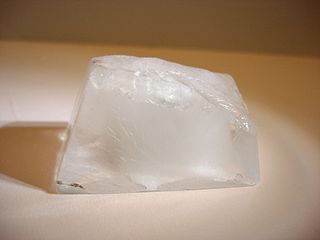
Pagophagia is the compulsive consumption of ice or iced drinks. It is a form of the disorder known as pica, which in Latin refers to a magpie that eats everything indiscriminately. Its medical definition refers to the persistent consumption of nonnutritive substances for over a period of at least one month. However, different studies have included alternative definitions including "daily consumption of 2-11 full glasses of ice (480-2640g)" or "the purposeful ingestion of at least one ordinary tray of ice daily for a period in excess of two months." Pagophagia has been shown to be associated with iron-deficiency anemia and responsive to iron supplementation, leading some investigators to postulate that some forms of pica may be the result of nutritional deficiency.
A food craving is an intense desire to consume a specific food, and is different from normal hunger. It may or may not be related to specific hunger, the drive to consume particular nutrients that is well-studied in animals. In studies of food cravings, chocolate and chocolate confectioneries almost always top the list of foods people say they crave; this craving is referred to as chocoholism. The craving of non-food items as food is called pica.
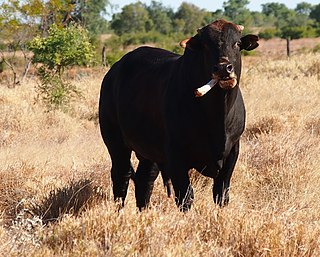
Osteophagy is the practice in which animals, usually herbivores, consume bones. Most vegetation around the world lacks sufficient amounts of phosphate. Phosphorus is an essential mineral for all animals, as it plays a major role in the formation of the skeletal system, and is necessary for many biological processes including: energy metabolism, protein synthesis, cell signaling, and lactation. Phosphate deficiencies can cause physiological side effects, especially pertaining to the reproductive system, as well as side effects of delayed growth and failure to regenerate new bone. The importance of having sufficient amounts of phosphorus further resides in the physiological importance of maintaining a proper phosphorus to calcium ratio. Having a Ca:P ratio of 2:1 is important for the absorption of these minerals, as deviations from this optimal ratio can inhibit their absorption. Dietary calcium and phosphorus ratio, along with vitamin D, regulates bone mineralization and turnover by affecting calcium and phosphorus transport and absorption in the intestine.
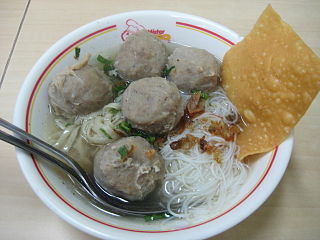
Bakso or baso is an Indonesian meatball, or a meat paste made from beef surimi. Its texture is similar to the Chinese beef ball, fish ball, or pork ball. The word bakso may refer to a single meatball or the complete dish of meatball soup. Mie bakso refers to bakso served with yellow noodles and rice vermicelli, while bakso kuah refers to bakso soup served without noodles.

Javanese culture is the culture of the Javanese people. Javanese culture is centered in the provinces of Central Java, Yogyakarta and East Java in Indonesia. Due to various migrations, it can also be found in other parts of the world, such as Suriname, the broader Indonesian archipelago region, Cape Malay, Malaysia, Singapore, Netherlands and other countries. The migrants bring with them various aspects of Javanese cultures such as Gamelan music, traditional dances and art of Wayang kulit shadow play.

Lontong is an Indonesian dish made of compressed rice cake in the form of a cylinder wrapped inside a banana leaf, commonly found in Indonesia, Malaysia, and Singapore. Rice is rolled inside a banana leaf and boiled, then cut into small cakes as a staple food replacement for steamed rice. The texture is similar to that of ketupat, with the difference being that the ketupat container is made from woven janur fronds, while lontong uses banana leaf instead.
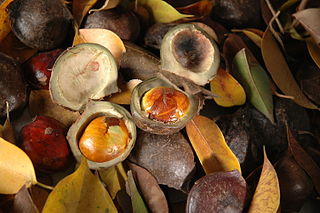
Archidendron pauciflorum, commonly known as djenkol, jengkol or jering is a species of flowering tree in the pea family, Fabaceae. It is native to Southeast Asia, where the seeds are a popular dish. They are mainly consumed in Indonesia, Thailand, Myanmar, and Vietnam, prepared by frying, boiling, or roasting, and eaten raw. The beans are mildly toxic due to the presence of djenkolic acid, an amino acid that causes djenkolism. The beans and leaves of the djenkol tree are traditionally used for medicinal purposes such as purifying the blood. To date, djenkol is traded on local markets only.

The use of medicinal clay in folk medicine goes back to prehistoric times. Indigenous peoples around the world still use clay widely, which is related to geophagy. The first recorded use of medicinal clay goes back to ancient Mesopotamia.

Dirt is an unclean matter, especially when in contact with a person's clothes, skin, or possessions. In such cases, they are said to become dirty. Common types of dirt include:
Research into food preferences in older adults and seniors considers how people's dietary experiences change with ageing, and helps people understand how taste, nutrition, and food choices can change throughout one's lifetime; particularly when people approach the age of 70, or beyond. Influencing variables can include: social and cultural environment, gender and/or personal habits, and also physical and mental health. Scientific studies have been performed to explain why people like or dislike certain foods and what factors may affect these preferences.

Chaoqi is a traditional Chinese snack. It is made with dough pieces covered with Guanyin clay, a kind of soil. The primary raw materials for making Chaoqi are flour, edible oil, egg, sugar, salt, and sesame. It has various flavors like milk flavor, sesame flavor, and five spices flavor.
Food psychology is the psychological study of how people choose the food they eat, along with food and eating behaviors. Food psychology is an applied psychology, using existing psychological methods and findings to understand food choice and eating behaviors. Factors studied by food psychology include food cravings, sensory experiences of food, perceptions of food security and food safety, price, available product information such as nutrition labeling and the purchasing environment. Food psychology also encompasses broader sociocultural factors such as cultural perspectives on food, public awareness of "what constitutes a sustainable diet", and food marketing including "food fraud" where ingredients are intentionally motivated for economic gain as opposed to nutritional value. These factors are considered to interact with each other along with an individual's history of food choices to form new food choices and eating behaviors.
References
- 1 2 (in Indonesian) Ampo, Camilan dari Tanah Liat. indosiar.com Archived August 31, 2014, at the Wayback Machine
- ↑ Ampo, Snack Made By Soil. Do You Believe It? hubpages.com [ permanent dead link ]
- ↑ Think twice before you say ew 2013 Flavor Boulevard
- ↑ Press, ed. (1997). "Indonesian Food and Nutrition Progress Volumes 4-6". Food and Nutrition Development and Research Center, Gadjah Mada University. p. 46. Retrieved 15 September 2020.
- 1 2 Asprihanto, Heru, ed. (17 March 2010). "Indonesian village snacks on soil for better health". Reuters. Retrieved 15 September 2020.
- ↑ Peter Abrahams, Human Geophagy: A Review of Its Distribution, Causes, and Implications. in H. Catherine W. Skinner, Antony R. Berger, Geology and health: closing the gap. Oxford University Press US, 2003, p. 33. ISBN 0-19-516204-8
- ↑ Pica Encyclopedia of Mental Disorders
- ↑ (in Indonesian) NEWS & FEATURES / HEALTH CONCERN - ARTIKEL - Kompas.com "Makan Tanah Liat Baik untuk Pencernaan?". 8 June 2011. Retrieved 2013-08-22.
- ↑ Makan Tanah Itu Liat Baik www.kopimaya.com
- ↑ Sera Young from Cornell University, New York, United States, study about geophagy .
- ↑ Unik Aneh. Ampo, Makanan Khas Tuban yang Terbuat dari Tanah Liat
- ↑ "unik aneh - Inilah Satu-Satunya Suku yang Memakan Tanah Liat Panggang" (in Indonesian). Retrieved 2013-08-22.
- ↑ Revkin, A. C. 1983. Paraquat: A potent weed killer is killing people. Science Digest 91(6):36-38, 42, 100-104.
- ↑ Kwong, A.M.; Henry, J. (2003). "Why is geophagy treated like dirt?". Deviant Behavior. 24 (4): 353–371. doi:10.1080/713840222. S2CID 144401343.